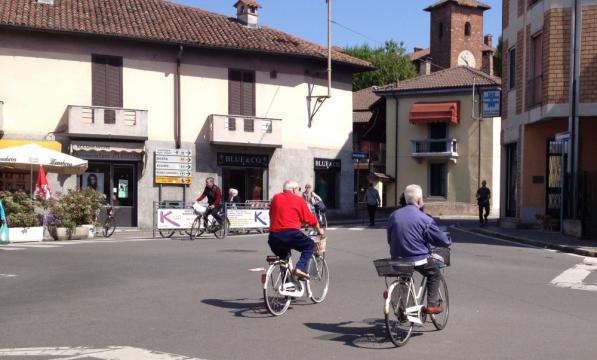Small town cycling: where Britain falls far behind

Italy is not a place we normally look to for lessons on cycling, but perhaps we should.
On a recent trip, I visited a small town on the outskirts of Milan, in the vast, flat and densely populated landscape of the Po valley.
With a population of around 7,000, the town of Binasco bears only slender resemblance to similar sized British towns. Much of the population is housed in modern apartments near a town centre, which still retains the old network of narrow streets around a castle.
High density = short trips
This results in a compact, dense town, with nowhere more than 2 kms from the town centre. This is a distance which is further than most people are prepared to walk - particularly if encumbered with shopping - but makes for a very easy cycle ride.
That shopping is almost exclusively done in a small, lightly trafficked and semi-pedestrianised area in the town centre adjacent to the castle and, when I was there on a Saturday morning, it was packed with bicycles and people enjoying their morning coffee.
One way for cars, another way for bikes
The narrow streets around the town centre were subject to one-way streets, but all appeared to allow two-way cycling. There aren't any signs indicating this, but, as in the photo above (which shows two elderly gents riding into a narrow one-way street against the flow), everyone was happily cycling against the one-way signs, and drivers appeared to accept this.
Perhaps this works because the levels of cycling are so high, so every - in Britain, where cycling levels are lower, attitudes to cyclists riding (illegally) against the flow are likely to be less relaxed, while drivers may not anticipate the presence of cyclists.
Pavements in the town are virtually non-existent, so people had to walk on the road, further reinforcing the need to reduce speeds. This may also be why many people carried children with them on bikes (almost universally without helmets!): push chairs would be unsuitable in a town where so many of the footways were below 70cms wide.
Historical legacy, or planned for cycling?
How much of this cycling culture emerged from luck - topography, medieval street layouts and value of land dictating housing density and lack of car parking - and how much through a planned prioritisation of non-car modes? Or perhaps these two factors combine: the lack of roadspace means that authorities have to provide for non-motorised modes, or risk the car killing off the central area.
It is this combination of factors that have meant that places like Cambridge and Oxford have retained a culture of cycling. Movement by private car in and out of the historic centre (where most retail, employment and leisure opportunities still are located) is greatly restricted for most of the time, while cycling is given reasonably free access.
And, likewise, it is the absence of these factors in so many other parts of Britain that has allowed car use to go unchecked. The result has been out-of-town shopping centres and business parks, often located in areas utterly inaccessible to cyclists. Even in city centres, 1960s transport planning led to distributor roads run right to the core of towns, with very small pedestrianised precincts located as close as possible to large multi-storey car parks.

